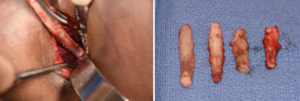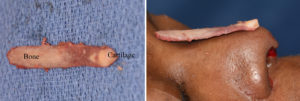Background: Rib removal is most commonly performed for aesthetic purposes for horizontal waistline reduction. During this procedure the free floating ribs (#s 11 and 12) and sometimes rib #10 are partially removed to allow the waistline soft tissues to collapse inward. As a result the procedure produces a lot of rib bone which is typically discarded.
In rhinoplasty surgery significant augmentation of the dorsum requires a large amount of autologous grafts or implants. When an autologous graft is chosen the rib donor site offers the largest amount of material. It is usually a completely cartilaginous graft as that is the easiest to carve into the desired augmentation shape. A complete cartilaginous graft must be harvested from either the subcostal ribcage or the cartilaginous sections of the upper ribs closest to the sternum.
The use of a costochondral rib graft has a long history in augmentation rhinoplasty. It is one of the more historic and still accepted grafts for the nose that requires augmentation from the radix down to the nasal tip. The cartilage end to this largely bony rib graft is important as that is what will be setting and pushing on the nasal tip skin. The thinner nasal tip skin will tolerate the push of cartilage underneath better than that of more solid bone.
Case Study: This female was to undergo a combined rib removal and rhinoplasty procedure. She had a prior augmentative rhinoplasty but her radix and nasal tip remained underprojected. It was decided to use the more bony ribs that would be readily available from the subtotal rib removals for her waistline reduction/reshaping.


The use of a costochondral rib graft for nasal augmentation is rarely used today although it remains an acceptable graft choice. The rare opportunity to perform rib removal and a concurrent augmentative rhinoplasty allowed an historic nasal graft option to be the preferred choice.
Highlights:
1) Rib removal for waistline reduction creates a discard of rib grafting material.
2) In rhinoplasty rib grafting is one accepted augmentation material.
3) The combination of rib removal and rhinoplasty provide a synergistic opportunity for a lot of choice in rib graft material.
Dr. Barry Eppley
Indianapolis, Indiana


